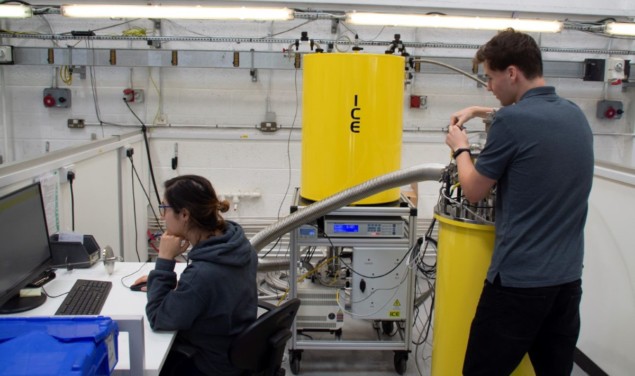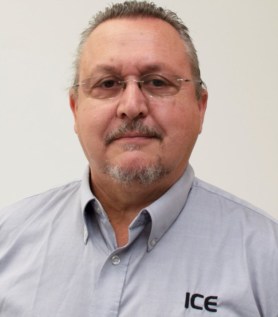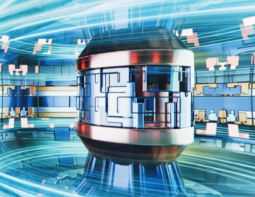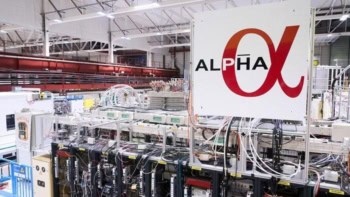ICEoxford’s emphasis on versatile product design, rapid cool-down and a high degree of automation eases the path to ultralow temperatures

ICEoxford, as the name suggests, is in the business of keeping things cold – ultracold to be precise. As such, the UK-based designer and manufacturer of specialist cryogenic systems supports fundamental and applied research efforts across a diverse customer base – from neutron and X-ray beamline scientists to quantum computing start-ups; from scanning-probe microscopy specialists to physicists studying the fundamental properties of high-temperature superconductors. “Generally, our customers want to get cold, get cold as quickly as possible, plus many want the option of studying their samples within a magnetic field,” explains Paul Kelly, Chief Technical Officer at ICEoxford.
With those requirements in mind, Kelly and his colleagues in Oxfordshire have pioneered the DRY ICE 1.5K 100 mm, a closed-loop cryostat that enables users to carry out experiments in the temperature range from 1.3 K to 325 K while ensuring tight tolerance on temperature stability (±10 mK below 10 K), fast cool-down times (<30 min to 1.4 K) and minimal vibration in the sample space (as little as ±100 nm). There’s also the option to add 3He and dilution-fridge inserts to achieve even lower temperatures (300 mK and 15 mK respectively).
Kelly, for his part, is keen to emphasize the win-win of a 100 mm diameter sample space matched with the cryostat’s high-cooling-power capability (>30 mW at 1.75 K). “This is the largest available sample space and highest cooling power on the market for a variable-temperature-insert [VTI] cryostat,” he claims. Equally significant is the fast-track cool-down cycle – and particularly so for scientists allocated time on the beamlines of big-science facilities like the ISIS Neutron and Muon Source or the Diamond Light Source (both also in Oxfordshire).
“Beam time is expensive and scientific users only get a fixed slot to complete their experiments – typically just a few days,” adds Kelly. Smaller laboratories also benefit, with the rapid cool-down translating into enhanced productivity versus research output (e.g. fast sample pre-testing in the cryogenic systems of quantum computers).
Good vibrations
Given the varied, often unique, requirements of ICEoxford’s end-users, the vendor sets a high bar for its design, engineering and manufacturing teams. Their task, says Kelly, is to bring a versatility of approach to all customer relationships, with a relentless focus on delivering the best system to do the job. “We work closely with the customer to fully understand their requirements and will tailor the product design to meet their exact specifications,” he notes.

The DRY ICE 1.5K 100 mm provides a case study in versatility, not least in terms of its vibration performance. The system can utilize two types of cryocooler: a Gifford-McMahon (GM) set-up (which relies on a mobile piston for compression and expansion of the helium fluid in the cold-head) or pulse-tube refrigerator (PTR) technology (with no moving parts in the low-temperature region). “Most users don’t see vibration as a show-stopper,” says Kelly, “but those who do are likely to choose PTR cooling, as the vibration is approaching an order of magnitude lower than GM.”
Further damping comes with the use of so-called “ICE sock” technology, a common method of vibration isolation across a range of ICEoxford products. “Put simply,” explains Kelly, “we build a container called a sock to surround the cryocooler. We then load the cooler into the sock and hold it away from any mechanical parts on a bellows.” A range of anti-vibration frames are also available to suit bespoke laboratory requirements, with product R&D ongoing to achieve even lower vibration levels (<50 nm at the sample space).
Versatile product design is further evidenced in ICEoxford’s patented Dual-Cool technology, which enables the DRY ICE 1.5K 100 mm system to switch between static and dynamic exchange-gas mode for sample cooling. Essentially, dynamic mode yields higher cooling powers, and in turn faster cool-down, after the sample probe is loaded into the cryostat at room temperature. After this initial cooling, however, most users want the sample to be in a more stable vacuum or low-pressure, static-gas environment for their experiments, swapping from dynamic to static mode once the sample approaches target temperature.
Magnetic attractions
Cooling aside, high-field superconducting magnets are designed to be an integral part of the DRY ICE 1.5K 100 mm system, with ICEoxford offering a range of solenoid, split-pair and vector-rotate magnets up to 18 T field strength. While studies of magnetic properties at ultralow temperatures are a given, many scientists also want to carry out simultaneous optical investigations of their materials – not so easy if the sample is sat within the large coil of a solenoid magnet.
In this case, one option is to load the sample into the bore of a split-pair magnet. “The DRY ICE system can be designed with a number of optical windows to allow, for example, laser spectroscopy experiments in transmission or reflection mode,” explains Kelly. The use of two- or three-way vector-rotate magnets provides further flexibility, with the latter able to generate a magnetic field in three discrete directions. In this way, it is possible to keep the sample stationary while the magnetic field is varied around it – a key feature when studying a specific plane within a crystal lattice or if the heat generated by sample rotation is a source of interference for small-scale electrical conductivity measurements.

Some like it cold: cryogenic innovation forges quantum opportunities
One other notable feature of the DRY ICE portfolio is the high degree of automation, with LabVIEW-based software used to control and monitor temperature in the DRY ICE 1.5K 100 mm system. “This has been developed with the customer in mind,” concludes Kelly, “to reduce the set-up and turnaround time of the system while increasing laboratory productivity.” What’s more, it’s possible to add features to the software such as integrated control for the superconducting magnet as well as automating the top-load and probe cool-down.
Variants of the DRY ICE 1.5K cryostat are also available in configurations with 30, 50 or 70 mm diameter sample space.




